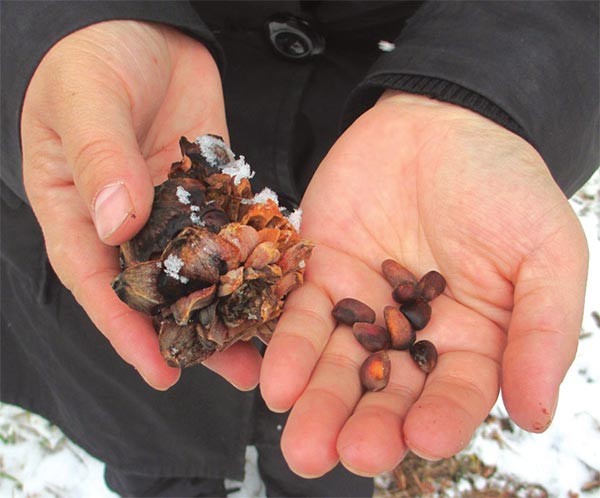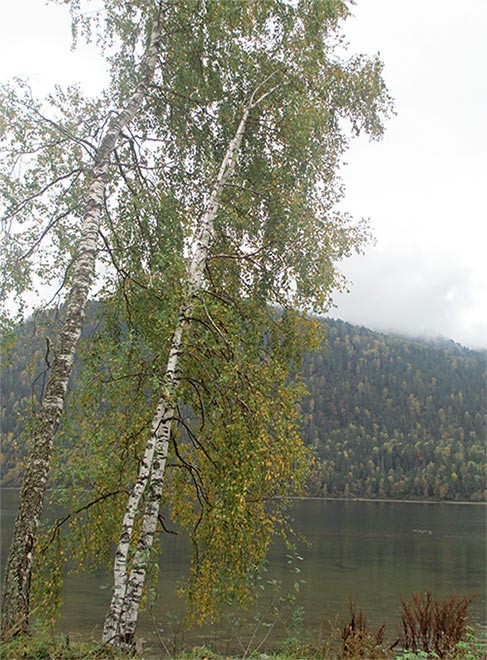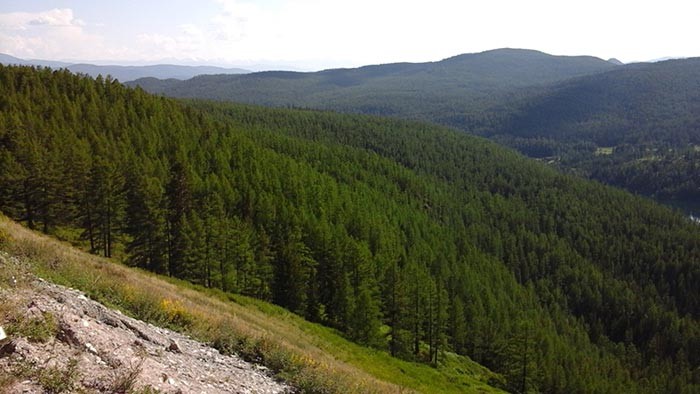Globally speaking, annual precipitation and temperature are the two most important factors that determine what grows where on Earth. Close to the equator, where it’s warm and wet, there’s a lot of plant life and a lot of diversity. In the far north, where it’s extremely cold and dry, forests are simpler and more homogenous. The Northeast is a temperate place that’s nevertheless defined, ecologically, by its long, cold winters. When plants live in places with below-freezing temperatures that prevent access to liquid water for several months of the year, they have a limited set of survival strategies. And so it’s not surprising that we can travel within the same band of latitude halfway around the world and find ecosystems that are strangely similar to our own, if not quite the same.
I live and teach in the Adirondacks, and in 2015, I took a group of students to the Altai Republic in Siberia for the purpose of comparing the ecology of these two mountainous, northern forest systems. Gorno-Altaisk, the capital of the Altai Republic, is located at 52 degrees latitude, a little farther north than Paul Smith’s, New York (44 degrees latitude). Both ecosystems are very close to the transition zones of other biomes (areas defined by the dominant vegetation, like forest or tundra). In the northern Adirondacks, the northern hardwood forest is heavily sprinkled with conifers, and in the lowlands there are lots of shrubby wetlands. In these wetlands, and in areas at higher elevations, we see a transition into the boreal biome that’s common across much of Canada, Scandinavia, and Russia. In the Altai, average annual temperatures are only slightly colder than in the northeastern U.S., but the climate is much dryer, with only about half as much annual rainfall as in the Adirondacks. The low elevations of the Altai feature mixed forests of the shrub-woodland biome type, but in the higher, drier, and colder spots, familiar genera transition into more arid-adapted species in a biome known as the steppe – a low-growing community of grasses mixed with small flowering plants and shrubs in shades of pale green and brown.
We started our exploration of Siberia in Gorno-Altaisk, a name that translates to “Golden Mountains.” Gorno has approximately 60,000 inhabitants and sits about 290 meters above sea level, roughly 200 meters lower in elevation than Paul Smith’s. The surrounding rolling hills are easily reached by walking through neighborhoods of small wooden houses that dot the hillsides on the outskirts of town. Silver birch, Betula pendula, the national tree of Russia, is a very common sight: singly, in clusters, or in large stands. True to its Latin name, it has a pendulous (drooping or weeping) appearance. These trees are so iconic in Russia that when I was there on a visit in 2012 working with school children, nearly all depictions of nature by fourth graders had a rendition of silver birches.
At low elevations, forests have a familiar open understory that includes bracken fern, deciduous shrubs, and a rich herb and moss layer. Higher in the hills around Gorno, birch and poplar mix with two-needled pines, making a shady place for families to “take rest in the forest” and harvest mushrooms on weekends in the early autumn. In Altai (and other parts of Asia and Europe), Scots pines (Pinus sylvestris) are native and stand straight and tall. Interestingly, in the Adirondacks there is an abundance of Scots pine, but they are not native and often have double leaders and very crooked stems that sometimes give them a Seussian appearance. Several theories exist about the differences in growth forms between continents, but the mystery remains unsolved.
Mostly east and a bit south is Lake Teletskoye. This picturesque rift lake – longer than Lake George but shorter than Lake Champlain – is up to 1,000 feet deep. At a similar elevation as Paul Smith’s in the Adirondacks, the structure and genera of the surrounding Siberian forest remind me very much of the forests that grow on poor, sandy soils around my home. Birch, poplar, and Scots pine grow in the lowland, and fir and spruce on the steep slope surrounding the lake. In the understory, there are familiar genera like St. Johnswort and yarrow, dogwood, and sumac, to name a few.
Traveling south, small villages line a roughly 300-mile-long rollercoaster ride of valleys and gradually higher mountain passes that eventually ends in a high, protected mountain area along the Mongolian border. These changes in elevation mimic changes in latitude: going up is like going north. The vegetation structure as you travel up mountains is complicated and determined by the combination of temperature and precipitation, which in turn are influenced by aspect and elevation. In the comparatively low mountains of the Adirondacks, temperatures drop as you climb, but the tops of the mountains are still wet with rain and cloud deposition in summer and melting drifts of snow in spring. In the Altai Mountains, which are almost three times as tall, there is a broader range of temperature and moisture and a greater variety of vegetation zones. In this way, the mountain ecosystems at the higher elevations are much more similar to the eastern sides of western North American mountains – drier and colder.
The mountain forests about 1.5 hours’ drive south of Gorno, on Seminsky pass, at an elevation nearly 1,000 feet higher than New York’s Mt. Marcy, are predominantly coniferous, with fir (Abies siberica) and a five-needled pine (Pinus siberica) that’s shorter and stouter than our familiar stately white pine (Pinus strobus). The five-needled pine cones produce large nuts that are valued by native Altaians and harvested and sold as snacks at overlooks or other high points on mountain passes, and even at kiosks on Red Square in Moscow. I have used them in pesto, and they are delicious.
Farther south and even higher up the elevation gradient, trees get sparser, and the understory opens up into more grassland, transitioning into steppe. At the height of Cheke-toman pass, Siberian larch (Larix sibirica) is the last tree standing before trees are gone altogether. In this way, I am reminded of larches that are found at higher and drier elevations in our western states compared to our Northeastern Larix laricina, which we find surrounding lower-elevation lake edges. This might seem paradoxical, but high, dry slopes with thin soils and low wetland areas with saturated soils share something in common: in both places, water uptake is difficult and nutrient availability is low. In high and dry, it’s the lack of available soil volume, water in the soil, and low decomposition rates accentuated by cold temperature. In the saturated soil of wetlands, oxygen is limiting to root respiration (even though wetland plants have adaptations to transfer oxygen to roots), and the uptake of water and nutrients are compromised. Decomposition is reduced by acidity and the slow work of anaerobic bacteria. Larches reabsorb a high proportion of nitrogen from their needles under low-nutrient conditions – more than deciduous trees do from their leaves. And while conifers that keep their needles run the risk of losing water through the cuticles of their needles during severe winters, larches shed their needles each fall and aren’t susceptible to this water loss.
Around Kurai, the most southerly village in which we stayed, the floor of the valley is steppe, where the silver-green hues and sweet fragrance of several species of sage indicate arid conditions. We traveled through a band of mixed conifer forest on our way up to the alpine zone, where glaciers are still present but receding rapidly at roughly 50 feet per year. Lichens, mosses, and dwarf round-leaf birches, even edelweiss, end where the talus begins. Some 14,000 years ago, a great continental ice sheet substantially lowered, softened, and smoothed out the peaks of the Adirondacks. Remnants of the U-shaped valleys formed by ancient alpine glaciers on the sides of sharp mountain peaks persist in only a few places in the Adirondack High Peaks, but in the Altai, they are preeminent and add to the majesty as the mountains rise up out of the steppe. Thus, even though we were in the presence of some familiar genera, the valleys and mountains were so different from our Northeastern home that we were awed by the contrast. We were in new territory here.







